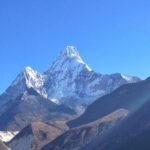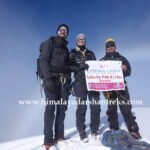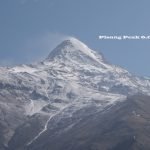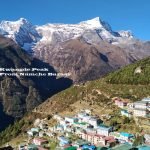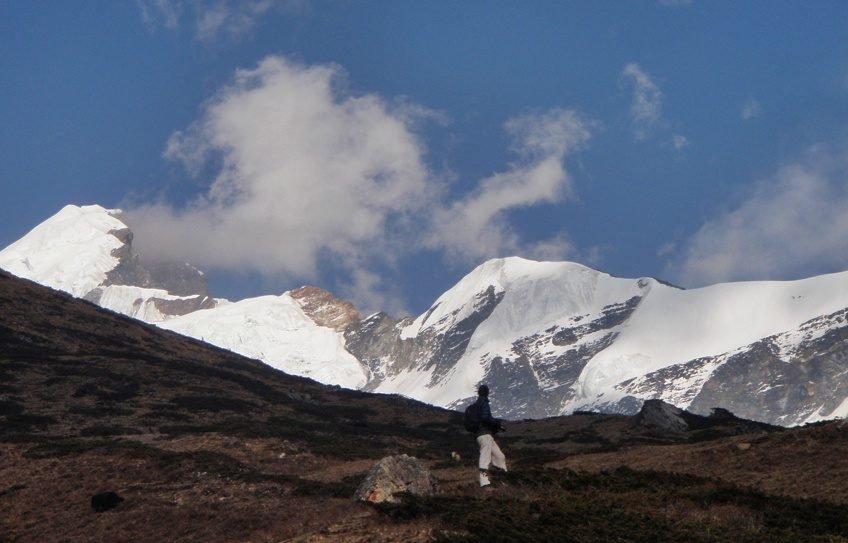

$2990
Per person - All price inclusive
-
Trip Grade:
Challenging -
Max-Altitude:
Summit 6,584m -
Best Season:
Spring Season -
Trip Mode:
Tea house + Camping -
Group Size:
Min 2+ -
Destination:
Annapurna Region
Chulu East Peak Climbing
The Climbing Chulu East Peak is a popular hiking peak in the Annapurna Region. Situated in the Manang district of the Annapurna Conservation Area. Especially, this 6,584m summit provides amazing views of Annapurna II, III, and IV. Likewise, Gangapurna, Glacier Dome, Dhaulagiri, Tilicho Peak, and Mt Manaslu are all noteworthy.
Mainly, Climbing Chulu Peak is linked with the famous Annapurna massif climb, a journey to Tilicho Lake, and a follow of the Marshyangdi Valley. As well as crossing the Thorong La Pass, the walk continues down the Kali Gandaki valley to Pokhara.
Whatever, Climbing Chulu Peak is simple in terms of technique, and you should be comfortable with your gear. Crampons, harnesses, ice ax, knot tying, and climbing rope handling are all skills that may be learned. In addition, the majority of the climbing is done in a roped group, including the glacial crossings. You have to be physically fit and have prior climbing experience.
Chulu East Peak Climbing Difficulty Level
Chulu East Peak climbing is considered a strenuous and technical climb. It requires previous mountaineering experience and a good level of physical fitness to successfully climb. The climb involves navigating through rocky and snowy terrains, and using technical equipment like crampons, ice axes, and ropes. The peak is 6,584 meters (21,601 feet) high, making it challenging to climb. Likewise, Climbers need to be prepared for high altitude conditions and unpredictable weather.
Best Time
The best time to climb Chulu East Peak is during the spring season (March to May) and autumn season (September to November). These periods offer stable weather conditions, clear skies, and moderate temperatures, making climbing more enjoyable.
If you’re planning a climb, targeting spring or autumn will give you the best experience.
Chulu East Climbing Permit Fee
The permit fees depend on the climbing season. The permit cost is higher in the spring season. It is the best mountaineering Peak Climbing season. Because the peak is less than 6,500m, the Chulu west permit is less expensive than the east. Fee stretchers for the Chulu East Peak Climbing Permit Fees are as follows:
- Spring season (March, April, and May) Per Person –USD 400
- Autumn season (September, October, and November) per person – USD 200
- Winter season (December, January, and February) per person – USD 100
- Summer season (June, July, and August) per person – USD 100
Finally, if you’re up for the challenge, Chulu East Peak offers an exhilarating adventure with stunning views of the surrounding Himalayas. Let us know if you need more information or have any other questions.
FAQs for Chulu East Peak Climbing
What is the best time to climb Chulu East Peak?
The best time to climb this Peak is during the spring season (March to May) and autumn season (September to November). These periods offer stable weather conditions, clear skies, and moderate temperatures, making climbing more enjoyable and safe.
How difficult is Chulu East Peak climbing?
Basically, Chulu East Peak climbing is consider a strenuous and technical climb. It requires previous mountaineering experience and a good level of physical fitness for the great success of the climb. The climb involves navigating through rocky and snowy terrains, and using technical equipment.
What gear do I need for Chulu East Peak climbing?
You will need a comprehensive set of gear, including general trekking equipment, technical climbing gear, and personal items. Some essential items include a down jacket, 4-season sleeping bag, crampons, ice axe, climbing harness, and trekking poles.
Do I need a permit to climb Chulu East?
Yes, you need a climbing permit from the Nepal Mountaineering Association (NMA) to climb Chulu East Peak. Additionally, you will need an Annapurna Conservation Area Permit (ACAP).
How long does it take to climb Chulu East Peak?
The entire expedition, including trekking to the Annapurna Circuit Trek and acclimatization, typically takes around 18 to 20 days. The duration may vary depending on the itinerary and weather conditions.
What is the altitude of Chulu East Peak?
Chulu East Peak stands at an impressive altitude of 6,584 meters (21,601 feet).
Is prior climbing experience necessary?
Yes, prior climbing experience is highly recommend for Chulu East climb. The climb involves technical sections and high-altitude conditions, so familiarity with mountaineering techniques and equipment is essential.
What are the accommodation options during the climb?
Accommodation options during the Annapurna circuit, Thorong La pass include teahouses, lodges, and during the climbing, camping/Tented accommodation.
What kind of physical fitness is require?
A good level of physical fitness is essential for Chulu East Peak climbing. You should be able to trek for several hours a day, carry a backpack, and handle the physical demands of high-altitude climbing.
Are there any health risks with high-altitude climbing?
Yes, high-altitude climbing carries risks such as altitude sickness, dehydration, and extreme weather conditions. It’s important to acclimatize properly.
Equipment/Gear
We at Himalaya Darshan Treks are highly recommended for good quality equipment for the successful and safe summit of Peak Climbing. The quality equipment makes your Peak climbing comfortable and safe. Before the climbing, our Climbing Sherpa/guide checks your equipment and assists in how to use this equipment/climbing gear. We always give priority to your safety and the success of your climbing which means you are in safe hands.
1, Clothing:
Quick-drying shirts and thermal tops and bottoms.
Fleece jackets or vests
Down Jacket (Good quality)
Windproof and Waterproof Jacket (Gore-Tex or similar)
Rain Jacket
Fleece or insulated pants
Waterproof pants to protect from rain and snow.
2, Head Wear:
Warm hat (wool or fleece)
Balaclava or neck gaiter
Sun hat or cap
3, Hand wear
Lightweight gloves (fleece or wool)
Insulated gloves or mittens
4, Personal Climbing Gears:
Climbing Harness
Crampons (compatible with your boots)
Helmet
Ice axe
5, Footwear:
Mountaineering/Climbing Boots
Crampons
Waterproof gaiters
Thick and warm mountaineering socks
A pair of slip-on shoes or sandals.
6, Personal Items
Polarized and UV-protected sunglasses
Mountaineering goggles
Sunscreen and Lip balm
Good quality Headlamp with extra batteries.
Camera and mobile Charger (Adapter)
First Aid Medical Kit
Energy bars (Snacks) lightweight.
Essential Items
Backpack (duffel bag and day bag)
Good quality Sleeping Bag
Trekking Poles
Hydration:
Insulated water bottle
Water purification tablets or filter
Itinerary
Day 1, Arrive in Kathmandu, transfer to hotel.
Day 2, Drive to Besisahar to Jagat (1300m). Stay at tea house.
Day 3, Trek to Dharapani (1900m) Stay at tea house.
Day 4, Trek to Chame (2,710m), Stay at tea house.
Day 5, Trek to Upper Pisang (3,300m) Stay at tea house.
Day 6, Trek to Manang (3,540m). Stay at tea house.
Day 7, Acclimatization Day. (Hike to ICE Lake)
Day 8, Trek to Yak Kharka (4,050m) Stay at tea house
Day 9, Trek to Chulu East Base Camp (4,900 m).
Day 10, Trek from Base Camp to High Camp (4,955m).
Day 11, Hike to Chulu East Summit 6,584m and return to Base Camp.
Day 12, Trek descend to Ledar (4,200m)
Day 13, Trek from Ledar to Thorong Phedi (4,510m).
Day 14, Trek from Thorong Phedi to Muktinath (3,800m) via Thorong La Pass 5,416m)
Day 15, Trek from Muktinath to Jomsom.
Day 16, Fly from Jomsom to Pokhara transfer to hotel.
Day 17, Drive from Pokhara to Kathmandu by tourist bus.
Day 18, Final Departure
Trip Includes
- Chulu East Peak Climbing permit and all needed documents for climbing.
- The necessary number of porters and staff with salaries, food, lodge, and insurance.
- Experienced and Professional Climbing Sherpa with equipment, salary, food, accommodation, and insurance.
- Experienced and gov. license holder trekking guide with salary, food, accommodation, and insurance.
- Cook and Kitchen Staff during the climbing.
- Accommodation and 3 times meals(breakfast, lunch, dinner, and tea/coffee) during the trekking and climbing.
- Tents with sleeping mattress during the climbing.
- All necessary kitchen & camping equipment during the climbing.
- 3 nights hotel in Kathmandu and 1-night hotel in Pokhara with bed and breakfast.
- Annapurna conservation entry permit and TIMS card.
- All airport/hotel transport by private vehicle.
- Garbage deposit $ 250.
- All government and local taxes.
- Transportation, Kathmandu to Besisahar and Besisahar to Kathmandu.
- Farewell dinner with culture program.
Trip Excludes
- Lunch and Dinner in Kathmandu and Pokhara (and also in the case of early return from trekking than the scheduled itinerary).
- Your Personal expenses (phone calls, laundry, bar bills, battery recharge, WIFI, extra porters, bottle or boiled water, shower, etc).
- Personal climbing equipment.
- Cost of an emergency evacuation.
- Extra night accommodation in Kathmandu and Pokhara because of early arrival, late departure, and Early return from trekking (due to any reason) than the scheduled itinerary.
- Tips for Guide and Porter.
- Your travel insurance (Nessecery).
Photo Gallery
Responses & Ratings
Related Packages
-
Ama Dablam Expedition - 27 Days
Ama Dablam, also known as Amai Dablang, popularly known as the 'Matterhorn...
- Max-Altitude: Summit 6812m
- |
- Group Size: Min 2+
-
Lobuche Peak Climbing - 16 Days
Are you seeking Lobuche Peak Climbing? and want to get experience climbing...
- Max-Altitude: Summit 6,119m
- |
- Group Size: Min 1+
-
Pisang Peak Climbing - 18 Days
Pisang Peak, at 6,091 meters, is one of Nepal's most beautiful summits....
- Max-Altitude: Summit 6,095m
- |
- Group Size: Min 2
-
Kwangde Peak Climbing - 15 Days
The top of Kwangde In the Khumbu area, climbing is a popular...
- Max-Altitude: 6,012m
- |
- Group Size: Min 1+

